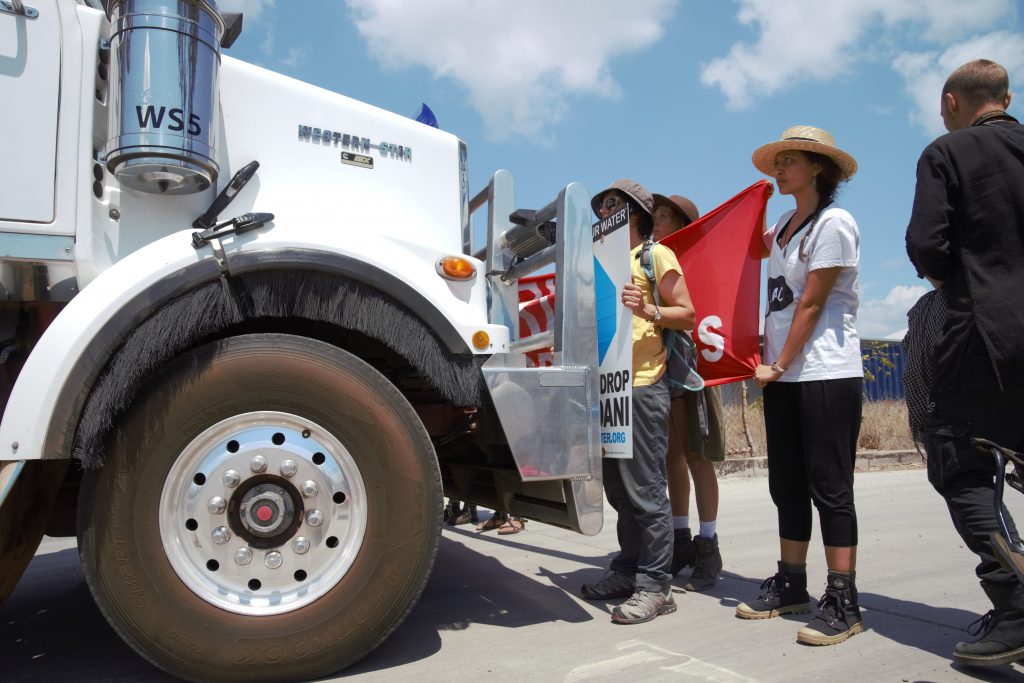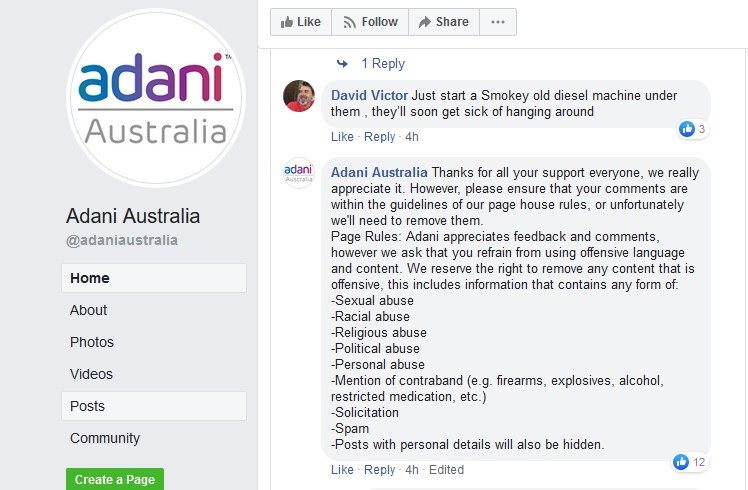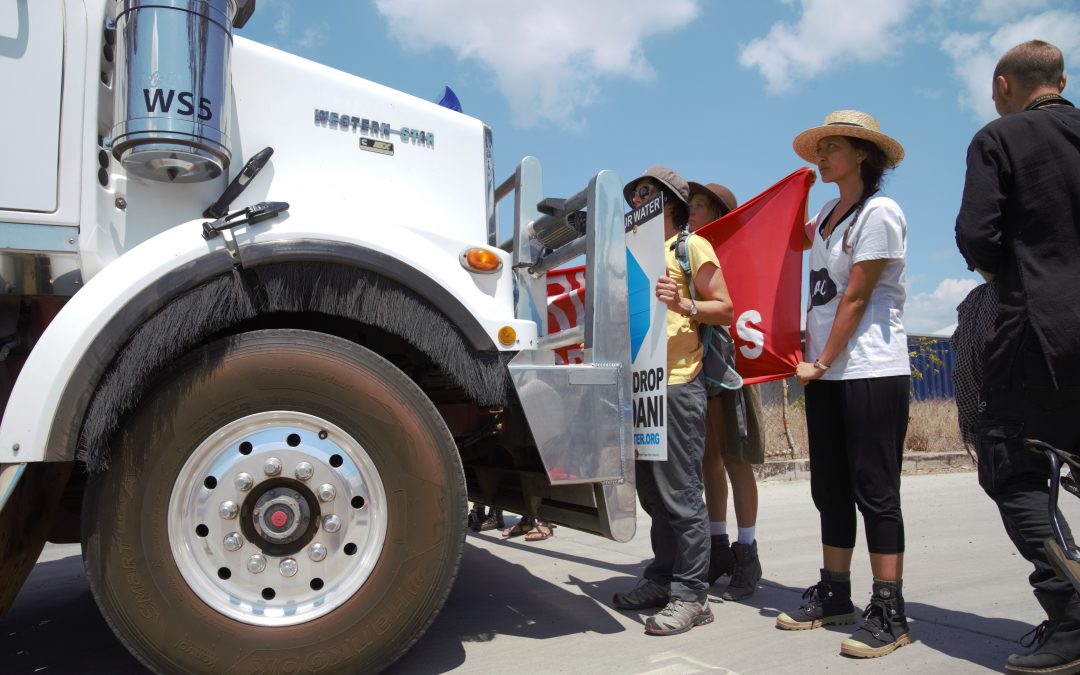Living at Camp Binbee, welcoming new people is a regular task. As part of the process introducing them to the camp, everyone signs a document saying they agree to the campaign’s protocol of non-violence – towards one another, towards people we come into contact with, as a political tactic.
Anyone who wants to be a part of protest actions must first take part in a day of Non-Violent Direct Action training. Among other things, we explore questions of what is violence, ask ourselves how we respond to stressful situations, and we discuss conflict de-escalation. As part of the latter, we do a simulation where one person plays the role of an angry worker confronted with a blockade, and the other person practices techniques to de-escalate the situation while standing firm.
This roleplay is a fundamental part of the training because it is a situation that plays out frequently at protests, or even on the streets up here. We don’t want those instances getting out of hand, and we don’t want to send every well-intentioned environmentally-minded person out there to face it without at least preparing them beforehand.
On one recent occasion, I was organising this part of the training. One woman broke down in tears, apologising and explaining she had been in an abusive relationship for a long time and being yelled at was triggering. We stopped the exercise, I went aside with her, and after a few deep breaths checked she was ok. Afterwards, I was kicking myself. I should have thought about this being a likely scenario given the nature of so many relationships in our society. Since that day I have always prefaced the simulation with a warning.

Three times in the last month or so there have been picket lines up here where a car or truck has seen people blocking the road and accelerated, before slamming on the brakes just in front of them. If you’re not used to having a car intentionally drive towards you at speed, it is pretty confronting. Each time we do a debrief, checking everybody is ok and giving a space to talk about it. Each time there are suggestions of extra safety practices we could put in place, which we then try to implement. Mostly though, us old-timers give a resigned shrug. Intense as it may be, this is a normal part of protest life.
A couple of weeks ago a security guard got in the face of one of our participants. “Do you want to live to see tomorrow?” he asked. Not the kind of threat that makes you think your life is actually in danger, just the usual intimidation trash talk. Our person verbally arked up in response, and came back apologetic and disappointed he hadn’t stayed more composed.
Six weeks ago, there was another action where someone was heading towards a drill rig. He was carrying a lock-on pipe – one of the Queensland government’s so-called “dangerous attachment devices”. The security guard tackled him. Literally jumped on his back. Another participant pulled the security guard off. A scuffle ensued, and a young woman stepped in to calm down the situation. The lock-on was attached to the rig, work was stopped, and tensions relaxed. The group of protesters shared snacks with the security guard, who said it was his first day at work. Everything was amicable.
Once the police arrived, the security (presumably under instruction from his boss) told the cops he had been assaulted and wanted to press charges. It wasn’t the first time Adani had attempted to charge protesters with assault, though their last attempt had fallen short because there was literally not a single piece of evidence to back up their claims. This time though, physical contact had occurred, and police arrested two people for assault and “deprivation of liberty”.
From custody, I received a call from the young woman, asking for legal advice. I offered her some quick tips and a bit of moral support. Alone in the watch-house, charged with assault though she had been the one defusing the situation, in a crazy position she was completely unprepared for; she was doing remarkably well. At one point though she started crying. “I didn’t assault anyone” she said, “I don’t know why they are saying I did.”
At that moment, Adani was putting out a public statement: “The Queensland Police Service has taken into custody a number of anti-coal activists who assaulted one of our people today at our rail construction site north of Clermont. The contractor employee who was the subject of the physical assault, along with other employees present during the incident, are being attended to and supported. Actions taken today by anti-coal activists were not peaceful or safe, and put simply this type of behaviour is unacceptable.”
On August 20, Premier Annastacia Palaszczuk announced new laws targeted at political protesters who use lock-on devices, or as the law calls them “dangerous attachment devices”. The laws could send to prison for up to two years anyone using a lock-on, as well as giving police new stop and search powers. To justify the laws, she claimed she had been shown evidence of lock-ons “laced with dangerous traps” intended to injure police officers.
I’ve written plenty already in other places about these claims, but to be succinct, they were a lie. The evidence wasn’t there, and the next day when asked by The Guardian, Queensland police wouldn’t back up the premier’s claims. Palaszczuk wilfully misrepresented nonviolent protests to serve her purpose in claiming laws aimed at criminalising dissent were really about police safety.
That day, an ABC reporter called me to talk about the laws. I went through all the answers I had prepared – the claims are sensationalised, we take safety seriously, civil disobedience has a long and honourable history, the real threat to safety is climate change. After about 5 minutes of him pressing me repeatedly on whether we put explosives in lock-ons, I exclaimed “this is crazy! We lock ourselves onto these devices, not anybody else!”
I will admit though that these actions contain an element of danger. The participant goes in defenceless with a lot of trust for the skills and goodwill of police rescue operators. If people express to me a desire to take actions like this, I prepare them for potential hazards. Police are skilled and experienced at disassembling these devices I tell them, but you just have to be prepared for their intimidation tactics. They will almost certainly take away any water you have (to the extent of cutting off camelpaks with a knife), as well as any sun protection. They may threaten you with what will happen should their power tools “slip”. It’s nothing to worry too much about, just some of the normal tactics of the people our government authorises to use violence if needed to enforce social expectations.
Over the years I’ve had these conversations dozens of times. I care about people’s wellbeing and want them to be mentally prepared. If it’s women, I tell them to be ready for police or workers to make crass comments, even to joke about assaulting them while they are locked up. This is an experience very common to women in those circumstances, a few I know have actually been groped while locked on. Can anybody honestly say that surprises them?
On social media, we usually have somebody whose job it is to moderate comments and take down abusive and threatening ones. Some of the comments are pretty awful, though nothing remarkable by social media standards. I know we’re not the only ones who have to deal with it – literally every time Adani posts about us on their facebook page they have to do a similar moderation job. They even have a template post they put up every time – it says “While we do appreciate feedback and comments we ask that you refrain from using offensive language or content that contains any form of racial, political, personal or sexual abuse as well as mentions of contraband (e.g. firearms, explosives, alcohol, restricted medication, etc.). Posts containing such text will be hidden. Thank you.”

It’s often said that social media brings out the worst in people, that in front of a screen it’s easy to write things you would never say to someone’s face. That may be true, but how then do you explain the constant macho posturing of politicians when it comes to talking about protests? Labor MP for Townsville Scott Stewart said recently “if it was me I’d leave them chained to the gate and don’t give them any water”. To be honest that’s pretty mild. Who could forget Nationals MP George Christensen posting on his social media a photo of himself aiming a gun and paraphrasing Clint Eastwood to say “do you feel lucky, greenie punks?”

Earlier this year, when the Bob Brown Stop Adani convoy was headed north, former Whitsunday mayor Mike Brunker said “it’s quite possible a few of them are going to get a clipping”. Burdekin MP Dale Last said “I think these protesters will be left in no doubt they’ve walked into a hornet’s nest… They’re going to get a very, very hostile reception, I can assure you of that.”
As these politicians and more egged on the crowd at a pro-mining counter-protest, a 62 year old woman on the convoy was assaulted by a man on a horse and had to be airlifted to hospital. The politician tough-guy act didn’t end there though. Peter Dutton was in the news last week making veiled threats: “People should take these names and the photos of these people and distribute them as far and wide as they can so that we shame these people. Let their families know what you think of their behaviour.“
This week, following protests in Brisbane, Annastacia Palaszczuk was saying she wanted to rush through normal legal procedure to fast-track the “dangerous attachment device” laws. She said “This is specifically aimed at the use of dangerous devices, that are dangerous not only to the people that are using them, but to our emergency services personnel that actually have to free them and injure themselves doing so.”
That morning on breakfast television, Australian TV hall of fame member Kerri-Anne Kennerley said the response to protesters should be to “use them as a speedbump” or “put them in jail and forget to feed them”.
Last weekend, some people from the frontline camp went into the town of Bowen for a swim. Experience has taught some of the longer-term crew to recommend people don’t wear anything identifying themselves as activists in town. It’s never that hard to pick outsiders in a small town though, and one of the group was king-hit by a beefy security guard. He had his jaw broken in two places and was taken to hospital for surgery.
A supportive local put him up in their house while he recovered. At camp meeting, we reiterated the need for people to be wary when they go into town. What else would you expect really, when politicians and media endlessly go on about outsiders coming to town, vilifying and insinuating violent threats against us. I sat for a while chatting with people who witnessed the assault, checking they were ok. I talked on the phone to my friend who stayed to support the man in hospital, see if they needed anything.
Life goes on, and so does the campaign to try to stop our society’s out of control sprint into climate self-destruction. I turned on the computer and kept working on my submission to the government on a law that calls an inanimate piece of steel a “dangerous device”.
– Andy Paine


Recent Comments